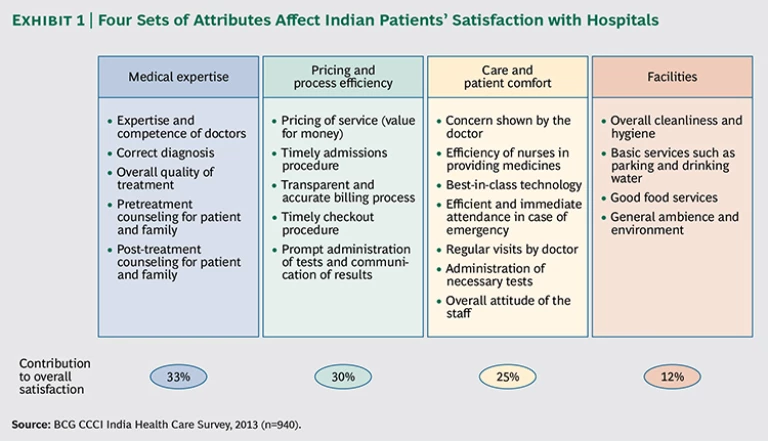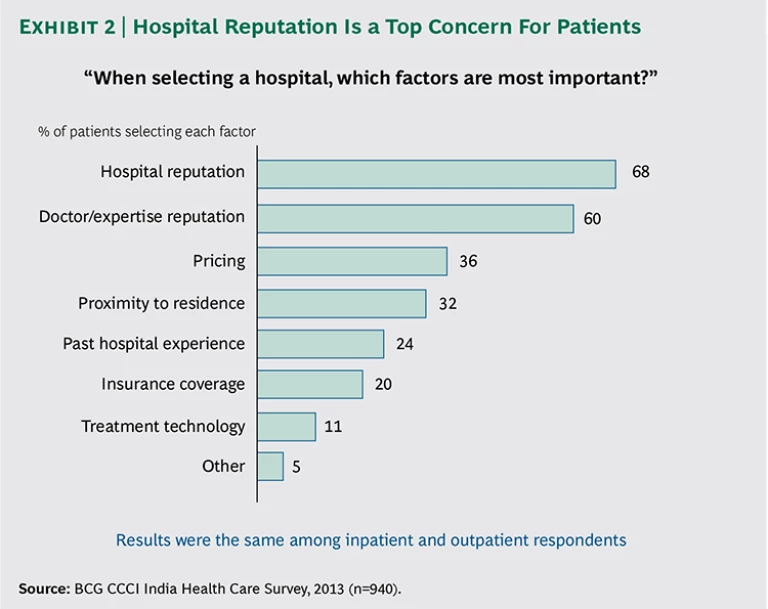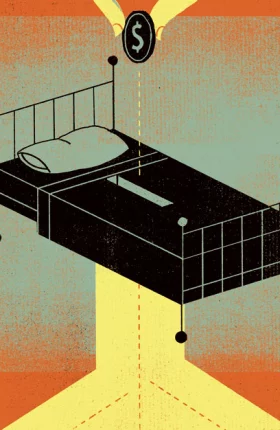Historically, hospitals in India had no problem filling beds. The majority operated at or near capacity most of the time, mainly because there weren’t enough beds to meet patient demand. But for an increasing number of hospitals, this may no longer be the case.
In recent years, Indian providers have invested heavily to build capacity, and this has benefited both patients and hospitals tremendously. In the last five years alone, top hospital chains have tripled their capacity to serve urban patients, and—largely as a result of these efforts—their revenues have quadrupled. In some of India’s urban centers, there are now
As the shortfall disappears in some markets and supply and demand come into balance, the basis of competition for providers is shifting. Patients will increasingly be able to select hospitals based on their needs and preferences. Growth in these markets will therefore depend on the ability to understand and meet patients’ diverse needs, and providers that continue to add capacity without differentiating their value propositions will reap diminishing returns.
Most providers, however, have not yet figured out how to identify the factors that drive patient behavior or increase satisfaction in this new health-care environment. They may not fully understand why patients select one hospital over another in the first place, and many have yet to develop deep insights into the factors that foster satisfaction over the course of inpatient or outpatient care. Thus, even those providers that focus on improving the patient experience often invest in areas that are not high priorities for patients.
The challenge is compounded by a number of factors, including patients’ tendency to rely on friends or family members when selecting a hospital. Patients are also becoming more like consumers in other industries, demanding better value for their money and requiring services that address more than their immediate medical concerns.
To help providers win in this environment, BCG’s Center for Consumer and Customer Insight surveyed nearly 1,000 Indian patients to identify the factors that drive patient satisfaction in health care. These interviewees—men and women of all ages with diverse socioeconomic and other demographic profiles—received care from seven of the top private hospital chains operating in 19 urban areas. We asked a variety of questions about their perceptions of and experience with providers across the care continuum. It was the first research effort of its kind ever conducted in India.
The survey enabled us to identify four broad drivers of patient satisfaction: medical expertise, pricing and process efficiency, care and patient comfort, and facilities. Based on this taxonomy, we derived six insights that providers can use to ensure that their value propositions meet patient needs.
Drivers of Patient Satisfaction
We identified 21 attributes that disproportionately shape satisfaction with hospitals among Indian patients. (For details about our methodology, see “Understanding Patients’ Needs.”)
UNDERSTANDING PATIENT'S NEEDS
Our findings are based on interviews with nearly 1,000 Indian patients who received care from the seven top Indian providers operating in 19 large cities3 throughout the country.
About half of these patients received inpatient care and about half received outpatient care. Collectively, they were treated for a spectrum of conditions, including ailments related to endocrinology (such as diabetes), cardiology, orthopedics, general surgery (such as for hernias and hemorrhoids), gynecology (including pregnancy), and oncology. The sample also represented diverse demographics in terms of gender, age (20 to 70 years), and income level4 (from “strugglers” to “elites”). When the patient was not the key decision maker, we interviewed the family member or friend who was.
We conducted the research in two phases: a qualitative phase based on interviews and a focus group, and a quantitative phase based on a detailed survey. Our objectives were to understand how patients select hospitals, assess their degree of satisfaction with key touch points across the health care experience, and determine which attributes of care are most important in shaping satisfaction.
To gauge their perceptions, we asked patients for their opinions regarding various aspects of care. To ensure that their perceptions were grounded in reality, we also asked specific questions about their actual experiences receiving care.
3. Providers were located in the following 19 cities: Ahmedabad, Bangalore, Chennai, Dehradun, Delhi, Gurgaon, Hyderabad, Jaipur, Kolkata, Madurai, Mangalore, Mumbai, Mysore, Nagpur, Noida, Pune, Raipur, Surat, and Vizag.
4. Income segments are defined as follows: “strugglers” earn less than $3,300 per year; the “next billion” earn from $3,300 to $7,399; “aspirers” earn from $7,400 to $18,499; “affluents” earn from $18,500 to $36,999; and “elites” earn $37,000 or more.
We used factor analysis techniques to group these attributes into four categories and to estimate the relative importance of each as a percentage of the potential contribution to overall satisfaction. (See Exhibit 1.)
Medical Expertise. Correct diagnoses, doctor competence, the perceived overall quality of treatment, and clear communication with patients and family members contribute 33 percent to patient satisfaction. Indian patients cannot use outcomes data to assess medical expertise, because most hospitals do not track or share this information. Before the first visit, patients usually base their assessment on recommendations from their general practitioner, family doctor, or family and friends. Once they begin to receive care, they assess medical expertise on the basis of factors such as the accuracy of the diagnosis and the quality of their interactions with medical professionals during pretreatment counseling.
Pricing and Process Efficiency. Pricing and logical, frictionless service delivery contribute 30 percent to satisfaction. Value for money, pricing transparency, and billing accuracy are the primary factors affecting satisfaction with pricing. Process efficiency depends on such factors as timely completion of admissions and checkout and prompt administration of medical tests.
Care and Patient Comfort. The level of attention to and regard for patients’ treatment experience contribute 25 percent to satisfaction. A hospital’s performance on care and comfort is affected by a variety of factors, from the concern shown by doctors and the efficiency with which nurses provide medications to the overall attitude of medical staff. Patient satisfaction also depends on whether doctors visit them regularly and whether staff responds immediately and efficiently in cases of emergency.
Facilities. The condition of buildings and the availability of basic services contribute 12 percent to satisfaction. Satisfaction with facilities depends on whether the hospital meets high standards of cleanliness and hygiene. Patients also require hospitals to provide basic services such as parking, clean drinking water, and cafeterias and other food options for visitors and to maintain a generally pleasant environment.
Six Insights into Patient Needs
The insights that we identified reflect the priorities that patients will act on with increasing frequency, particularly as the capacity shortfall fades in many markets. Providers that deliver on these priorities can build loyalty among their existing patients and attract new patients from providers that fail to meet expectations. Thus they can maintain and extend the gains achieved in recent decades by building new facilities and expanding existing ones.
Medical expertise, more than patient satisfaction, affects hospital selection. When selecting a hospital, patients prioritize medical expertise above all other factors except institutional quality (see “Institutional quality trumps doctor reputation,” below). Even in tier 2 and tier 3 cities, patients rank medical expertise above proximity and pricing as a criterion in hospital selection. However, Indian patients usually lack access to the information needed to assess the expertise of health care professionals over the course of care, and their satisfaction with the care they actually receive is often shaped most by factors not directly related to providers’ medical expertise.
In developed countries, patients and payers increasingly require hospitals to provide data about treatment outcomes, and payers increasingly reimburse hospitals based on their success in achieving the outcomes that matter most to patients. But in India, demand for outcomes data is just beginning to develop. As noted, over the past decade, most providers have focused on expanding capacity, and few have used outcomes data to differentiate themselves. In fact, most still
As a result, patients often judge providers based on their own experience without reference to the overall success rate of a treatment. They focus on factors that function as proxies for the quality of treatment, such as the quality of their interactions with doctors, nurses, and the technicians who conduct tests over the course of care. They also tend to focus on process efficiency, heavily weighting factors such as the delivery of medications and the administration of tests.
Given these realities, providers should take steps to educate patients and manage their expectations. For example, they can offer patients and their families high-quality pretreatment counseling that explains why a particular treatment is necessary and how likely it is to succeed and that informs them about how the institution meets high standards of care. They can also offer post-treatment counseling to help patients manage the transition out of the care environment. In the absence of data on outcomes, it is particularly important for providers to outperform on the nonmedical aspects of care, which have a disproportionate effect on patient satisfaction.
Process excellence is essential. Over the course of care, nonmedical factors are as important as medical expertise in shaping patient satisfaction. Efficient and caring service is critical.
Efficiency has to do with the ability to get things done within a reasonable period and with a minimum of inconvenience. Patients should not have to wait too long to undergo a procedure, and nurses should deliver the right medications on time. Satisfaction also depends on the ability to carry out basic business functions quickly and easily. Patients should not be required to wait for long periods to be admitted or checked out of a facility, and billing should be transparent, accurate, and timely. This kind of professionalism is important because patients are likely to question an institution’s commitment to excellence if they are not treated appropriately during every interaction, administrative as well as medical.
Caring service is about friendliness and concern for patients’ comfort and well-being. In certain respects, caring service is a process issue because it can be manifested through consistency and good customer-care procedures. Doctors should visit hospital patients regularly, and nurses and staff should treat them with compassion.
Pricing transparency rivals price. Satisfaction regarding price hinges on clearly communicating the cost of service. Patients are often sensitive about price but may be less so when told in advance how much a procedure or service costs. They typically prefer itemized bills that show the cost of each element of care. Surprises give people the sense that pricing is arbitrary; a patient may be pleased when something turns out to cost less than expected, but this may not increase satisfaction as much as receiving accurate pricing information at the outset.
Billing must also be accurate and timely, and patients should have an easy means of communicating directly with facility representatives about bills and payments. Billing staff should be friendly and willing to help, approaching every interaction as an opportunity to increase satisfaction.
Focus on the basics. Luxuries have little effect on satisfaction levels, but patients expect providers to meet basic standards of service. Most important, facilities must be hygienic and tidy, surfaces and equipment clean and sanitary, and hallways and rooms uncluttered and well lit. As noted above, patients also demand that hospitals provide basic conveniences such as parking spaces and clean drinking water. And there should be comfortable waiting rooms with televisions for visitors, as well as clean restrooms and affordable food options.
Patients do enjoy services such as free Wi-Fi and gourmet food options, but they don’t view these as necessities. Providers that offer beyond-the-basics services get little return on their investment and should reallocate resources to stronger drivers of satisfaction, such as improved clinical outcomes.
Institutional quality trumps the reputation of doctors. Hospital reputation is the most important factor affecting patients’ decision about where to go for care. (See Exhibit 2.) This is probably because reputation is a function of a hospital’s performance in the areas that matter most to patients. In fact, building a hospital’s brand is a more effective way to drive loyalty than hiring star doctors. Our research indicates that 90 percent of patients who select a hospital based on its reputation are likely to return to the hospital for care in the future, whereas only 75 percent of those who make their selection based on doctor reputation are likely to return.
This highlights a big opportunity for providers. Most hospitals have focused on assembling and maintaining a roster of well-known doctors, which can be a good way to attract first-time patients but is less effective in building loyalty. Moreover, few hospitals have made a concerted effort to differentiate their brand from those of competitors, and most patients do not perceive hospital brands to be very different from one another. Hospitals can increase loyalty by differentiating their brands on the basis of those attributes that matter most to patients—including medical and nonmedical processes that deliver a consistently superior experience across medical conditions and facilities.
Personal referrals reign, but the role of the Internet is increasing. Patients rely heavily on personal recommendations when selecting a hospital. Recommendations from trusted general practitioners are the most influential, but patients also put great stock in the experiences of family members and friends. Not surprisingly, many patients continue to see doctors with whom they have had a positive experience.
But almost as many patients now rely on the Internet as rely on such recommendations. Patients regularly check providers’ websites to research facilities, and many search online for information about diseases and medical terms. Sites such as Ask4Healthcare.com enable patients to connect with medical experts online and review providers and doctors. Hospitals are moving to the Internet at an accelerating pace, hosting patient forums and allowing patients to make appointments online. The use of mobile services is expected to increase rapidly in India, and online recommendations are likely to become more important as a result.
Building a Consumer-Centric Value Proposition
To differentiate their value propositions and strengthen their brands, providers should develop a clear understanding of their performance relating to the attributes that most affect patient satisfaction. They should also prioritize high-impact areas where delivering superior value will strengthen their relationships with patients and build a competitive advantage. Our research suggests that Indian providers should consider prioritizing medical expertise, process efficiency, and care and comfort.
Medical Expertise. Providers must develop a clear understanding of their performance on the clinical outcomes that matter most to patients. To do that, they will have to define metrics for each condition, systematically collect data to use as inputs for those metrics, and share their data—at least with clinicians—to ensure that they improve outcomes by enabling research in areas where performance falls short. Given the starting point for most Indian hospitals, it may be some time before they can share data with patients. In the short term, providers should establish mechanisms for communicating with patients about their medical status, from pretreatment counseling to regular interactions with doctors and nurses to post-treatment counseling.
Process Efficiency. Providers should analyze all processes that touch patients in order to make them less intrusive, easier to understand, and more systematic and reliable. Both medical and nonmedical processes should occur on time and with minimal friction, and providers should clearly explain why each is required, if this is not already obvious. For example, bills should be delivered promptly, charges should be clearly itemized and logical, and payment options should be intuitive. Medications should be delivered when expected, and admission and checkout should be systematic, quick, and easy.
Care and Comfort. Satisfaction is strongly affected by whether patients feel that doctors and nurses have a caring demeanor and strive to make patients as comfortable as possible. Health care professionals can often benefit from training that teaches them how to be more empathic and attentive to patients’ needs. But it is also important to establish the right processes, such as ensuring that doctors check in regularly with patients to monitor their progress firsthand. Providers can offer patients access to counselors and other support staff to help them navigate complications.
The health care sector in India is entering a new, consumer-centric era that will profoundly alter the competitive dynamics among providers. The increasing emphasis on patient satisfaction will be an engine for continuous improvement that will benefit patients and society, while enabling providers to establish sustainable competitive advantages. In the coming years, Indian providers that develop differentiated value propositions rooted in deep consumer insights will set a new standard for success in the country. They will grow by cultivating lasting relationships with patients and winning share from players that fail to prioritize patients’ needs. In the process, they will catalyze a new phase of development in India’s health-care market.
Acknowledgments
This publication is a collaboration between BCG’s Health Care practice and its Center for Consumer and Customer Insight. The authors would like to offer sincere thanks to their colleagues Indira Ghagare, Gaurav Jindal, Stefan Larsson, Shruti Patodia, and Nivedita Tripathi for their contributions. They would also like to acknowledge Robert Mertz for writing assistance, as well as Katherine Andrews, Gary Callahan, Angela DiBattista, Kim Friedman, Abigail Garland, Gina Goldstein, and Sara Strassenreiter for their contributions to editing, design, and production.







